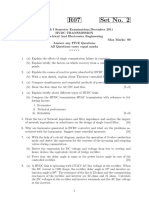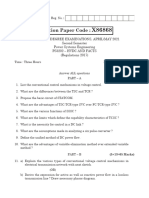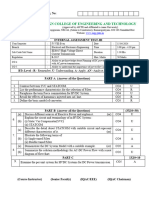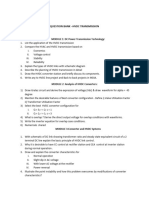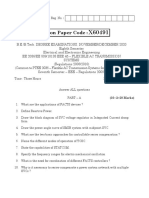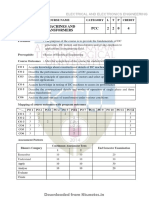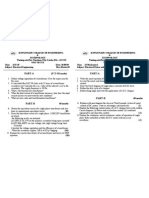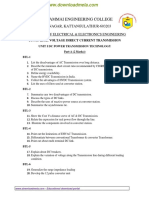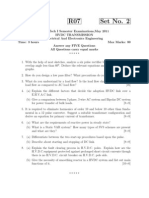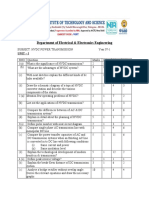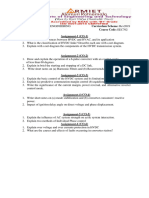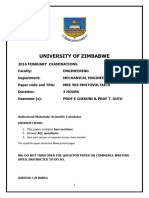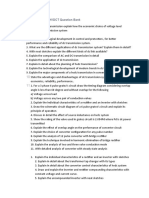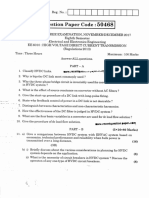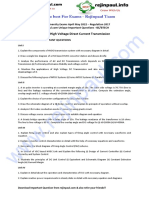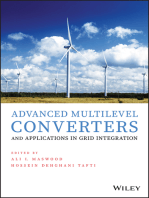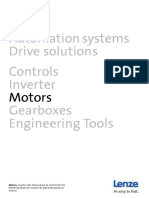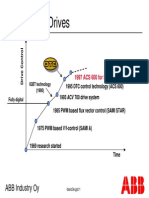HVDC & FACTS
HVDC & FACTS
Uploaded by
kankaroo6Copyright:
Available Formats
HVDC & FACTS
HVDC & FACTS
Uploaded by
kankaroo6Copyright
Available Formats
Share this document
Did you find this document useful?
Is this content inappropriate?
Copyright:
Available Formats
HVDC & FACTS
HVDC & FACTS
Uploaded by
kankaroo6Copyright:
Available Formats
ELECTRICAL AND ELECTRONICS
CODE COURSE NAME CATEGORY L T P CREDITS
EET466 HVDC AND FACTS PEC 2 1 0 3
Preamble: This course introduces HVDC concepts and analysis of HVDC systems. It also
provides a detailed study of FACTS devices.
Prerequisite : Nil
Course Outcomes : After the completion of the course the student will be able to:
CO 1 Analyse current source and voltage source converters for HVDC systems
CO 2 Describe the control schemes for HVDC systems
CO 3 Explain the need for FACTS devices
CO 4 Classify reactive power compensators in power system
CO 5 Interpret series and shunt connected FACTS devices for power system applications
CO 6 Explain the dynamic interconnection mechanisms of FACTS devices
Mapping of course outcomes with program outcomes
PO PO PO PO PO PO PO PO PO PO PO PO
1 2 3 4 5 6 7 8 9 10 11 12
CO 1 3 3 2
CO 2 3 3 2
CO 3 3 3 2
CO 4 3 3 2
CO 5 3 3 2
CO 6 3 3 2
Assessment Pattern
Bloom’s Category Continuous Assessment
Tests End Semester Examination
1 2
Remember (K1) 20 20 40
Understand (K2) 20 20 40
Apply (K3) 10 10 20
Analyse (K4) - - -
Evaluate (K5) - - -
Create (K6) - - -
Downloaded from Ktunotes.in
ELECTRICAL AND ELECTRONICS
End Semester Examination Pattern : There will be two parts; Part A and Part B. Part A
contain 10 questions with 2 questions from each module, having 3 marks for each question.
Students should answer all questions. Part B contains 2 questions from each module of which
student should answer any one. Each question can have maximum 2 sub-divisions and carry
14 marks.
Course Level Assessment Questions
Course Outcome 1 (CO1):
1. Discuss the advantages of HVDC over HVAC (K2, PO1)
2. Explain various types of HVDC system (K2, PO1)
3. Explain various converters in HVDC system(K2, PO2)
Course Outcome 2 (CO2):
1. Discuss the control basics of two terminal link (K2, PO1)
2. Explain static Vd-Id characteristics of a HVDC system (K2, PO1)
3. Derive equivalent circuit of a two terminal HVDC link (K3, PO2)
Course Outcome 3 (CO3):
1. What is meant by voltage regulation? (K1,PO1, PO2)
2. With neat diagrams explain the effect of phase angle compensation (K2,PO1,PO2)
Course Outcome 4 (CO4):
1. Explain the principle of TSC. Also explain the effect of initial charge of the capacitor
in TSC. (K2, PO1, PO2)
2. Explain the principle and operation of STATCOM(K2, PO1, PO2)
Course Outcome 5 (CO5):
1. Explain with a neat circuit and necessary waveforms, the operation of IPFC. (K2,
PO1,PO2)
2. Explain the applications UPFC (K2, PO1)
Downloaded from Ktunotes.in
ELECTRICAL AND ELECTRONICS
Model Question Paper
QP CODE:
PAGES: 2
Reg. .No:______________
Name:______________
APJ ABDUL KALAM TECHNOLOGICAL UNIVERSITY
EIGHTH SEMESTER B. TECH DEGREE EXAMINATION,
MONTH & YEAR
Course Code: EET466
Course Name: HVDC AND FACTS
Max. Marks: 100 Duration: 3 Hours
PART A (3 x 10 = 30 Marks)
Answer all Questions. Each question carries 3 Marks
1. Explain the advantages of HVDC transmission system over HVAC.
2. What will be the effect on the Short Circuit MVA of a bus if an additional HVDC line
is connected to that bus?
3. Enumerate the functions of HVDC control.
4. Discuss any one method for extinction angle control in HVDC.
5. Why are FACTS controllers needed in AC power transmission systems?
6. Explain the effect of series compensation
7. Explain TSR controller with necessary waveforms
8. Explain with neat circuit and necessary waveforms, the operation of TSSC
9. Give the comparisons between UPFC and IPFC
10. Explain the working principle of Thyristor Controlled phase angle
Regulator
PART B (14 x 5 = 70 Marks)
Answer any one full question from each module. Each question carries 14 Marks
Module 1
11. a) Derive average output voltage of a 6 pulse converter with overlap (10)
b) Compare CSC and VSC. (4)
12. a) Explain VSC with AC voltage control with the help of schematic. (10)
b) Discuss the effect of delay angle in the reactive power requirement, in a HVDC
system. (4)
Downloaded from Ktunotes.in
ELECTRICAL AND ELECTRONICS
Module 2
13 a) Derive equivalent circuit of a two terminal HVDC link (10)
b) Explain the hierarchy of controls in HVDC system. (4)
14 a) Explain static Vd-Id characteristics of a HVDC system. (10)
b) Draw the schematic of current control at the rectifier end. (4)
Module 3
15 a) Explain the effect of shunt compensation with neat diagrams (8)
b) Give the comparisons between series and shunt compensators (6)
16 a) What is meant by power quality and voltage regulation?
Explain its significance in power systems ( 10)
b) List out different types of FACTS controllers. (4)
Module 4
17. Explain TCR controller. What are the different methods to eliminate harmonics? (14)
18. (a)Explain the principle and operation of SSSC compensation (4)
(b)Explain with diagrams, the different modes of TCSC controller (10)
Module 5
19.a) With neat diagram, explain the modes of operation of UPFC (8)
b)Explain with neat circuit, the operation of IPFC (6)
20.a) Explain the working principle of Thyristor Controlled Voltage e Regulator (4)
b) Explain the independent reactive power flow control (P&Q) characteristic of UPFC
(10)
Downloaded from Ktunotes.in
ELECTRICAL AND ELECTRONICS
Syllabus
Module 1
Introduction to HVDC System
Comparison of AC and DC Transmission - Types of HVDC system - Current Source
Converters - Analysis without and with overlap period. Voltage Source Converters (VSC) -
VSC with AC current control and VSC with AC voltage control
Module 2
HVDC Controls - Functions of HVDC Controls - Equivalent circuit for a two terminal DC
Link - Control Basics for a two terminal DC Link - Current Margin Control Method - Current
Control at the Rectifier - Inverter Extinction Angle Control - Hierarchy of Controls
Module 3
Introduction to FACTS
Power flow in Power Systems – Voltage regulation and reactive power flow control in Power
Systems - Power flow control -Constraints of maximum transmission line loading - Needs
and emergence of FACTS - Types of FACTS controllers-Advantages and disadvantages
Transmission line compensation- Uncompensated line -shunt compensation - Series
compensation -Phase angle control.
Module 4
Shunt and Series Facts Devices
Static shunt Compensator - Objectives of shunt compensations - Variable impedance type
VAR Generators -TCR, TSR, TSC, FC-TCR (Principle of operation and schematic) and -
STATCOM (Principle of operation and schematic).
Static Series compensator - Objectives of series compensations-Variable impedance type
series compensators - GCSC. TCSC, TSSC (Principle of operation and schematic)
Switching converter type Series Compensators-(SSSC) (Principle of operation and
schematic)
Module 5
UPFC AND IPFC
Unified Power Flow Controller: Circuit Arrangement, Operation of UPFC- Basic principle of
P and Q control- independent real and reactive power flow control- Applications
Introduction to interline power flow controller (IPFC) (Principle of operation and schematic)
Thyristor controlled Voltage and Phase angle Regulators (Principle of operation and
schematic)
Note: Simulation assignments may be given in MATLAB, SCILAB, PSAT, ETAP, PSCAD, etc.
Downloaded from Ktunotes.in
ELECTRICAL AND ELECTRONICS
Text Books
1. Vijay K Sood, “HVDC and FACTS Controllers”, Springer, 2004
2. N.G. Hingorani and L.Gyugyi, “Understanding FACTS”, IEEE Press 2000
References:
1. K.R.Padiyar, “High Voltage DC Transmission”, Wiley 1993
2. Y.H. Song and A.T.Jones, “Flexible AC Transmission systems (FACTS)”, IEEE
Press 1999.
3. K.R.Padiyar, “FACTS Controllers in Power Transmission and distribution”, New age
international Publishers 2007.
4. T.J.E. Miller, “Reactive Power control in Power systems”, John Wiley 1982.
5. C.L.Wadhwa, “Electric Power Systems”, New Academic Science Limited, 1992
Downloaded from Ktunotes.in
ELECTRICAL AND ELECTRONICS
Course Contents and Lecture Schedule:
No. of
No Topic
Lectures
1
HVDC Converters(6 hours)
1.1 Comparison of AC and DC Transmission Systems - Costs, Technical 1
considerations and reliability
1.2 Types of HVDC Links 1
1.3 Current Source Converters 2
1.4 Voltage Source Converters 2
2 HVDC Controls (7 hours)
2.1 Function of HVDC Controls 1
2.2 Control Basics of two terminal DC Link 2
2.3 Current Margin Control Method 1
2.4 Current Control at the rectifier 1
2.5 Inverter Extinction Angle Control 1
2.6 Hierarchy of Controls 1
3 Introduction to FACTS (6 hours)
Power flow in Power Systems – Voltage regulation and reactive power
3.1 flow control in Power Systems - Power flow control -Constraints of 2
maximum transmission line loading
Needs, emergence of FACTS- Types of FACTS controllers-Advantages
3.2 2
and disadvantages
Transmission line compensation- Uncompensated line shunt
3.3 compensation - Series compensation -Phase angle control. (line diagram, 2
vector diagram and expression for P and Q)
4 Shunt and Series Facts Devices (8 Hours)
4.1 Static shunt Compensator - Objectives of shunt compensations, 1
Variable impedance type VAR Generators -TCR , TSR, TSC, FC-TCR
4.2 2
(Principle of operation and schematic)
4.3 STATCOM- Principle of operation-and schematic 1
Downloaded from Ktunotes.in
ELECTRICAL AND ELECTRONICS
1
4.4 Static Series compensator - Objectives of series compensations
Variable impedance type series compensators - GCSC. TCSC, TSSC -
4.5 2
Principle of operation and schematic
Switching converter type Series Compensators-(SSSC)- Principle of
4.6 1
operation and schematic
5
UPFC AND IPFC (7 Hours)
Unified Power Flow Controller: Circuit Arrangement, Operation of
5.1 2
UPFC-
Basic principle of P and Q control- independent real and reactive power
5.2 2
flow control- Applications
5.3 Introduction to interline power flow controller (IPFC). 1
Thyristor controlled Voltage and Phase angle Regulators -Principle of
5.4 2
operation
Downloaded from Ktunotes.in
You might also like
- PS4351 HVDC and FactsDocument2 pagesPS4351 HVDC and Factsprasad2303No ratings yet
- MK100 Cnc3040 Spindle ReglagesDocument15 pagesMK100 Cnc3040 Spindle ReglagesSalah Bouziane0% (1)
- 07a70204 HvdctransmissionDocument5 pages07a70204 HvdctransmissionSamiullah Mohammed0% (1)
- LC SCDocument28 pagesLC SChardik033No ratings yet
- Fundamental of HVDC FACTS DevicesDocument4 pagesFundamental of HVDC FACTS DevicesgauthamNo ratings yet
- HVDC - FACTS Unit I Material SoftDocument17 pagesHVDC - FACTS Unit I Material SoftGokul M PNo ratings yet
- Switched Mode Power ConvertersDocument12 pagesSwitched Mode Power ConvertersabdulbasiththayyilNo ratings yet
- EET202 - Ktu QbankDocument8 pagesEET202 - Ktu QbankJisha KuruvillaNo ratings yet
- X86868 (PS5202)Document2 pagesX86868 (PS5202)naveenlearn1990No ratings yet
- S5 S6 Electrical & Electronics EngineeringDocument209 pagesS5 S6 Electrical & Electronics EngineeringThomas NigilNo ratings yet
- ELECTRICAL AND ELECTRONICS ENGINEERING - 2019-Scheme-S4-Syllabus - Ktustudents - in PDFDocument66 pagesELECTRICAL AND ELECTRONICS ENGINEERING - 2019-Scheme-S4-Syllabus - Ktustudents - in PDFgeethuNo ratings yet
- Ee8017 - HVDCT Iat IiiDocument1 pageEe8017 - HVDCT Iat Iiis.suresh k.swaminathanNo ratings yet
- Question Bank FactsDocument4 pagesQuestion Bank FactsprakashkerurNo ratings yet
- Facts QuestionsbankDocument7 pagesFacts Questionsbankjaackson10No ratings yet
- EET285-Dynamic Circuits and SystemsDocument9 pagesEET285-Dynamic Circuits and SystemsDeepa M SNo ratings yet
- Fundamental of HVDC FACTS DevicesDocument4 pagesFundamental of HVDC FACTS Devicessreenivasroyal80% (1)
- EET283-Introduction To Power EngineeringDocument9 pagesEET283-Introduction To Power EngineeringbinnytmzNo ratings yet
- VSC-FACTS-HVDC: Analysis, Modelling and Simulation in Power GridsFrom EverandVSC-FACTS-HVDC: Analysis, Modelling and Simulation in Power GridsNo ratings yet
- HVDC Question BankDocument3 pagesHVDC Question Banksks116270No ratings yet
- SUBJECT: Elective-I Flexible A.C. Transmission Systems (FACTS) Question Bank Unit-I:Introduction To FactsDocument4 pagesSUBJECT: Elective-I Flexible A.C. Transmission Systems (FACTS) Question Bank Unit-I:Introduction To FactsJagadish Babu KondraguntaNo ratings yet
- Question Bank: EighthDocument7 pagesQuestion Bank: EighthprakashNo ratings yet
- FACTS Question BankDocument7 pagesFACTS Question BankAnbarasan AnnamalaiNo ratings yet
- HVDCDocument5 pagesHVDCAlluri Appa RaoNo ratings yet
- Jntuworld: (Electrical & Electronics Engineering)Document4 pagesJntuworld: (Electrical & Electronics Engineering)VamsiCMCNo ratings yet
- Question Paper Code:: (10 2 20 Marks)Document2 pagesQuestion Paper Code:: (10 2 20 Marks)gunasekaran RajendranNo ratings yet
- EET203-Measurements and InstrumentationDocument9 pagesEET203-Measurements and Instrumentationalbin2005jkNo ratings yet
- Ee8017 High Voltage Direct Current TransmissionDocument12 pagesEe8017 High Voltage Direct Current TransmissionRaja AjithNo ratings yet
- Gujarat Technological UniversityDocument1 pageGujarat Technological UniversityChintan PatelNo ratings yet
- DC Machines and TransformersDocument8 pagesDC Machines and TransformersAlakaaa PromodNo ratings yet
- Psoc Nov 2021Document3 pagesPsoc Nov 2021studyeeeforyourmtherNo ratings yet
- 2022,2023-B.tech-8th-Power - Quality - and-facts-EE PYQ BEUDocument5 pages2022,2023-B.tech-8th-Power - Quality - and-facts-EE PYQ BEUpawankumarmth00uNo ratings yet
- FACTS Question PapersDocument3 pagesFACTS Question PapersyelhankaNo ratings yet
- Electrical Engg QuesDocument1 pageElectrical Engg Quesjayj_5No ratings yet
- Short Answer Type Questions: Unit Ii Voltage Source ConvertersDocument7 pagesShort Answer Type Questions: Unit Ii Voltage Source ConvertersBhanu Ganesh LukkaNo ratings yet
- HVDC&FACTS - Unitwise Important Questions-1Document2 pagesHVDC&FACTS - Unitwise Important Questions-1kondurumahi50No ratings yet
- PSOC Model II - Set2Document2 pagesPSOC Model II - Set2Vidhya Priya SenthilNo ratings yet
- 1.2 QN PapersDocument12 pages1.2 QN PapersAlinoor AbdiNo ratings yet
- PS7005 High Voltage Direct Current TransmissionDocument11 pagesPS7005 High Voltage Direct Current TransmissionWorkaholic KidNo ratings yet
- Special Electric MachinesDocument7 pagesSpecial Electric MachinesashiqulaslamtkNo ratings yet
- R07 Set No. 2Document4 pagesR07 Set No. 2Phani VarmaNo ratings yet
- Ee 010 706-L01-HVDC Transmission - EeDocument2 pagesEe 010 706-L01-HVDC Transmission - EeFrancis TomyNo ratings yet
- Department of Electrical & Electronics Engineering: Unit - IDocument6 pagesDepartment of Electrical & Electronics Engineering: Unit - IPreetham SurepallyNo ratings yet
- Analog ElectronicsDocument9 pagesAnalog ElectronicsAadarshNo ratings yet
- HVDC QBDocument6 pagesHVDC QBThiaga RajanNo ratings yet
- 22EET402 Model Paper 2.docx2024Document2 pages22EET402 Model Paper 2.docx2024pgirija309No ratings yet
- Question Paper Code:: Reg. No.Document3 pagesQuestion Paper Code:: Reg. No.Ruban PonrajNo ratings yet
- Stucor Qp-Ee8702Document7 pagesStucor Qp-Ee8702georgypsaju870No ratings yet
- HVDC Question BankDocument4 pagesHVDC Question BankHari Pavan0391No ratings yet
- Gujarat Technological UniversityDocument1 pageGujarat Technological UniversityChaitanya ShahNo ratings yet
- HVDC Transmission Question BankDocument7 pagesHVDC Transmission Question BankVarshareddie 2104No ratings yet
- HVDC &facts Course Plan 1Document4 pagesHVDC &facts Course Plan 1Padukolai KarupaiahNo ratings yet
- 40189(BE8255)Document2 pages40189(BE8255)ksathishkmNo ratings yet
- Assignments - HVDCT - 23-24 ...Document1 pageAssignments - HVDCT - 23-24 ...dipuNo ratings yet
- Lakireddy Bali Reddy College of Engineering (Document9 pagesLakireddy Bali Reddy College of Engineering (raman yarramilliNo ratings yet
- EEE312 EEE282 Lab4 Spring2015 PDFDocument5 pagesEEE312 EEE282 Lab4 Spring2015 PDFvognarNo ratings yet
- Mre503 2016 02Document3 pagesMre503 2016 02gwemeowenNo ratings yet
- HVDCT Question BankDocument2 pagesHVDCT Question BankPritesh PandyaNo ratings yet
- University Question Bank - EdcDocument16 pagesUniversity Question Bank - EdcSenthil IlangovanNo ratings yet
- Ee 6010Document2 pagesEe 6010Barath KumarNo ratings yet
- X10401 (Ee8552)Document3 pagesX10401 (Ee8552)Sujesh ChittarikkalNo ratings yet
- Ee8017 Rejinpaul IqDocument2 pagesEe8017 Rejinpaul IqSheik Sidthik AkbarNo ratings yet
- Advanced Multilevel Converters and Applications in Grid IntegrationFrom EverandAdvanced Multilevel Converters and Applications in Grid IntegrationAli Iftekhar MaswoodNo ratings yet
- Nordbloc.1 Series Gearmotors & Speed Reducers: Intelligent DrivesystemsDocument268 pagesNordbloc.1 Series Gearmotors & Speed Reducers: Intelligent DrivesystemsOscar CruzNo ratings yet
- NS2000 Inveter MaunalDocument95 pagesNS2000 Inveter MaunaldanielaliNo ratings yet
- PDFDocument17 pagesPDFphyoagarNo ratings yet
- IET Power Electronics - 2021 - Saadat - Adaptive Neuro Fuzzy Inference Systems ANFIS Controller Design On Single PhaseDocument14 pagesIET Power Electronics - 2021 - Saadat - Adaptive Neuro Fuzzy Inference Systems ANFIS Controller Design On Single PhaseMahdi HERMASSINo ratings yet
- ARUM192168096BTE5Document4 pagesARUM192168096BTE5ingcivalflhNo ratings yet
- Electric Machines Considering Power ElectronicsDocument68 pagesElectric Machines Considering Power ElectronicsAnkit DalalNo ratings yet
- Zonergy CatalogDocument19 pagesZonergy CatalogSuban Tasir0% (1)
- Af0zp0ba (COMBIAC2-ing) PDFDocument65 pagesAf0zp0ba (COMBIAC2-ing) PDFtaurusNo ratings yet
- Sun2000 - (250ktl, 280ktl, 300ktl, 330ktl) Series User ManualDocument123 pagesSun2000 - (250ktl, 280ktl, 300ktl, 330ktl) Series User ManualsolisinverterstrNo ratings yet
- Hyundai Catalogue VRF Chiller 2022Document42 pagesHyundai Catalogue VRF Chiller 2022Mạnh ĐinhNo ratings yet
- Design of New Structure of Multilevel Inverter Based On Modified Absolute Sinusoidal PWM TechniqueDocument8 pagesDesign of New Structure of Multilevel Inverter Based On Modified Absolute Sinusoidal PWM TechniqueInternational Journal of Power Electronics and Drive SystemsNo ratings yet
- IJE Volume 36 Issue 10 Pages 1733-1745Document13 pagesIJE Volume 36 Issue 10 Pages 1733-1745saurabh guptaNo ratings yet
- AEG Motori Trifase UkDocument204 pagesAEG Motori Trifase UkadhiNo ratings yet
- Yaskawa vs626m5Document305 pagesYaskawa vs626m5tmsxptoNo ratings yet
- Course File PagesDocument20 pagesCourse File PagesrajivNo ratings yet
- Ib63e46c - Melselect Instruction Manual enDocument52 pagesIb63e46c - Melselect Instruction Manual enJulio Perez RodriguezNo ratings yet
- Eastman Charger Circuit DiagramDocument33 pagesEastman Charger Circuit Diagramrajeshbattery821101No ratings yet
- Manual vlt6000 en PDFDocument178 pagesManual vlt6000 en PDFvivekskplNo ratings yet
- MHI Brochure (2019) PDFDocument132 pagesMHI Brochure (2019) PDFlechepinitoNo ratings yet
- Iec College of Engineering & Technology (Gr. Noida)Document20 pagesIec College of Engineering & Technology (Gr. Noida)Naveen KumarNo ratings yet
- Catalog - Hinc - Osp-55 - 160 Next2Document6 pagesCatalog - Hinc - Osp-55 - 160 Next2Anonymous mZEUquNo ratings yet
- B5X Motion Control System (B51 B55 B57 B58 ManualDocument88 pagesB5X Motion Control System (B51 B55 B57 B58 Manualgeovanni martinezNo ratings yet
- StepperDocument102 pagesStepperSander van OortNo ratings yet
- Dip Ipm App NoteDocument43 pagesDip Ipm App Noteamateur123456No ratings yet
- Catalog Inverter Mitsubishi F800Document138 pagesCatalog Inverter Mitsubishi F800Irvan FauziNo ratings yet
- ARMAN Feeds & Fisheries LTD: Morjal, Raipura, NarsingdiDocument2 pagesARMAN Feeds & Fisheries LTD: Morjal, Raipura, NarsingdiTanvirul islam fahimNo ratings yet
- 02 - 02 Basics of AC Drives Part 2Document16 pages02 - 02 Basics of AC Drives Part 2anshu4u06100% (1)
- Inverter To Motor WiringDocument2 pagesInverter To Motor WiringGalih Wicaksono100% (1)


